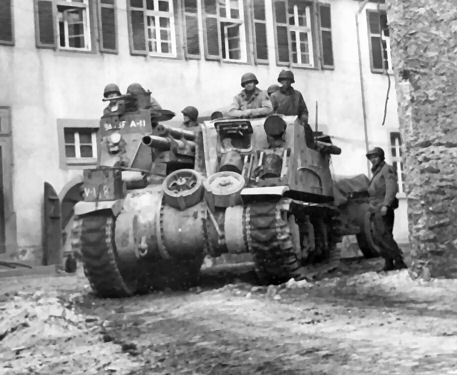by David Thibodeau
When I got back to the battery after my turn "up forward" with the forward observer, Capt. McGannon sent for me and told me the Lieutenant was impressed with my calmness under fire and wondered if I would like to be transferred to the Radio Section permanently. I said no thanks.
Our troops captured the big port of Cherbourg June 27, after the 9th Infantry Division had cut off the Cotentin Peninsula. The 4th Infantry Division's 105 howitzers were mounted on M-7 Tanks, called "Priests" because of the turret with a .50 cal. machine gun on the left side. The tank was open at the top and we rode up there on a sort of deck when we moved from one place to another.

Self propelled M7 Howitzer aka 'Priest'
When we went into a new position, we had to clear trees away from the guns, and often as not, we were cutting down the apple trees of the Norman French farmers. They did not seem overjoyed at our coming, and I read later that the Germans had got along with them OK. and paid them for the produce they needed. We shot up their cattle, cut down their apple trees, and caused other damage.
Strange high speed aircraft began going overhead quite low, so fast we couldn't see them. I read in the Army Newspaper, Stars and Stripes, about the V-1 German pilotless aircraft, and told my mates that was what they were. Nobody believed me. I started looking well ahead of the sound, and then could see a ghostlike object moving very fast. They were pulse-jets, small aircraft with a 1000 pound bomb in the body. The engines were very simple, a damper like device in a hollow tube. Fuel was injected, and when it exploded, the damper closed, giving it thrust. The partial vacuum thus created opened the damper, and as another jet of fuel entered the chamber, the residual heal re-ignited the mix, and so it went until the fuel ran out. After they passed over, the sound changed to a " pop-pop-pop." When the fuel ran out the V-1 would then dive to the ground. London was the target. The V-2 rockets came later.
We lived on three different kinds of field rations. C- Rations came in three cans, with meat and beans, hash, and candy and cigarets. K-Rations were in waxed boxes and were put up by the Cracker Jack Company. They contained cheese, meat, crackers, candy and cigarets. The 10-in-One Rations had a much greater variety. Our kitchen equipment caught up with us by late June, sent over from England.
Believe it or not, we washed our clothes in gasoline, while the poor civilians back in the States had a hard time getting it.
We moved often, to keep up with the Infantry, and the first thing we did after getting the guns ready for action, was to dig a hole. Getting caught in the open with no hole was a bad thing. If we stayed in a position more than a day or two, we roofed over our hole with sand-filled artillery shell cases, which were made of heavy composition material. You always slept in your hole.
The need for fresh men to go "up forward" never let up, and my turn would come up again in July, at Mortain, during a strong German counterattack that followed the big St.-Lo breakout from the hedgerow country.

